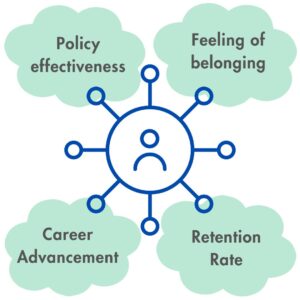Measuring the Impact of Your Organization’s Disability Inclusion
Pour la version française de cet article, veuillez cliquer ici. | For the French version of this post, please click here.
Whether you’re new to workplace disability inclusion or you’re well on your way, measuring the impact of your inclusion activities shows the progress you’ve made and what can be improved. It demonstrates your commitment to inclusion to both your staff and your clients/customers.
Are your inclusion policies and practices effective for job seekers and staff? Are they helping you achieve your personnel and organizational goals?
Below is a simple guide to measuring the impact of disability inclusion. Throughout the process, consultation with staff is paramount for an authentic, employee-informed result and further engagement.
What should I measure?
To find out what to measure, consult staff about the following two questions.

1. What are our goals for the inclusion plan?
What do you want to achieve with workplace inclusion? Think about your short-term and long-term goals.
Examples:
- Short-Term Inclusion Goals
- Clear policies and procedures around disability disclosure, accessibility, and accommodations are in place by December 2024.
- Six new inclusively-hired employees are in place by December 2025. (Inclusively-hired: hired while inclusion policies are in place.)
- Four of those new staff stay with us for at least three years each.
- Short-Term Inclusion Goals
- Long-Term Inclusion Goal (can sometimes be related to your organizational vision)
- An inclusive, supportive workplace culture that helps to retain staff and decrease turnover.
- Long-Term Inclusion Goal (can sometimes be related to your organizational vision)
Your inclusion goals can validate (prove the value and accuracy of) and directly influence your organization’s activities. They can also help you assess whether your activities are in line with your organizational vision.
2. How will we know if we've achieved our goals?
For some goals, the answer is clear. If you have six new inclusively-hired staff by December 2025, you’ve achieved that goal.
For less tangible goals, explore what success looks like in your day-to-day operations. For instance, if you want an inclusive, supportive workplace culture that retains staff, add realistic numbers and timelines to your goal.
Examples:
- By June 2025, 70% of staff will be “Very Satisfied” working at our company.
- By December 2028, we’ll have 4 inclusively-hired staff who have been with us for three years.
How should I measure it?
Once you know what success looks like, choose your metrics for each goal—the data you need to measure progress. Keep it simple.
Choose 2-3 quantitative metrics (data you measure with numbers).
For example, to retain 4 staff for three years, quantitative metrics might include:
- # (number of) existing staff, date hired, length of employment
- # staff who left, date hired/date left, length of employment
Collect data from 6-12 months before you implemented your inclusion plan to the present.
You can also track:
- # staff who identify as experiencing disability (if you have a disclosure process)
- # accommodation requests (# requests completed)
- # inclusion trainings (# staff attending)
- # staff who advance in their job (staff experiencing disability/staff without disability)
Add qualitative data (staff perspectives).
Qualitative data can help to explain the numbers.
Throughout the employment cycle, from hiring to retiring:
- What supports are missing?
- What’s working well?
- What could be improved?
- Do staff feel like they belong here?
- Are they engaged with the organization?
Refer to this CASE blog for accessible methods to collect employee feedback.
What do I do with all this data?
Analyze the results of the data. The word “analyze” can be intimidating, so again, keep it simple.
1. Examine the quantitative data: Over time, are the numbers going up or going down?
2. Examine the qualitative data: Does the staff feedback help to explain why the numbers might be going up or down at certain times?
3. While reviewing the data, create three lists:
- What’s working well
- What’s not working well
- What could be improved
4. Develop a simple action-oriented plan:
Based on your data and lists, adjust existing inclusion goals or create new ones, and develop a simple plan to achieve them. Your plan should include tasks and for each task:
- Financial and other resources required
- A timeline
- Who will implement it
- The status/progress made
Sample action-oriented plan in Excel:

Develop and implement this plan with staff and collect their input as you go. Keep goals and tasks realistic based on capacity.
Follow through with your plan to demonstrate your organization’s commitment to inclusion.

